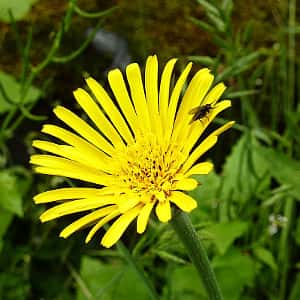
Arnica montana is a perennial flowering plant native to southern Russia and other mountainous areas in Europe.
In Germany, A. montana is a protected species, so the pharmacopoeia there includes the very similar species A. chamissonis. (French and Swiss pharmacopoeias do not permit this substitution.) Vernacular names include leopard’s bane and mountain tobacco.
There are also North American species of arnica (A. fulgens, A. sororia, A. latifolia, and A. cordifolia). All these species have attractive yellow daisy-like flowers, and all have been used medicinally for centuries. While the Europeans started using arnica back in the sixteenth century for digestive disorders, to reduce fever, and as a topical treatment for skin disorders, Native American groups were experimenting with other uses.
At one time the entire plant, including the rhizome (“root”) was used, but now only the flowers are included in herbal medicines. American settlers used tincture of arnica to soothe sore throats and improve circulation. The German philosopher Goethe is said to have used arnica tea as a remedy for chest pain. Current understanding of the potential toxicity of arnica, especially for the heart, has relegated its modern use to external applications and homeopathic tinctures.
Active Ingredients:
Arnica flowers contain a number of sesquiterpene lactones, with the exact mix and amount of each one varying from one species to another as well as with growing conditions. European standards specify “not less than 0.7 percent m/m of total lactone sesquiterpenes.” The primary ones are helenalin and related compounds. Acetic, isobutyric, and other carboxylic acids have also been identified.
Typically, a number of flavonoids are also present, including isoquercitrin, luteolin, kaempferol, quercitin, and astragalin. The pyrrolizidine alkaloids tussilagine and isotussilagine may pose a risk of hepatotoxicity. The flowers also contain caffeic acid and its derivatives and an essential oil containing fatty acids, carotenoids, and thymol derivatives, along with the coumarins umbelliferone and scopoletin.
Uses:
Arnica flowers in ointments, creams, or gels are most commonly used for the topical treatment of bruises and sprains. They have also been recommended for inflammation due to insect bites and for stiff, inflamed joints. Such remedies seem to have a mild anti-inflammatory effect with some ability to relieve pain.
Dermatologists who reviewed the medical literature concluded that there is insufficient evidence that arnica reduces post-surgery redness or swelling (Dermatologic Surgery, April 2016). They urged their colleagues to conduct studies.
In one double-blind trial, it reduced stiffness following a marathon run. Other studies have not demonstrated its superiority to placebo.
Helenalin and dihydrohelenalin have strong antibacterial activity. The European Scientific Cooperative on Phytotherapy suggests that arnica flower preparations may be gargled or applied to canker sores or inflamed gums (gingivitis).
One study of people following dental surgery for impacted wisdom teeth did not show any advantage of arnica flower mouthwash, however. The patients using metronidazole healed more rapidly, while those using arnica had greater inflammation and pain than those on placebo.
It is important not to swallow any arnica solution or gel used in the mouth; be sure to split it out and rinse the mouth out with water.
Arnica polysaccharides seem to stimulate the immune system and other constituents keep blood clots from forming. This property may help explain the traditional belief that arnica improves blood flow and heals bruises.
Despite these activities, traditional internal uses of this herb to stimulate the heart or improve blood flow are far too dangerous for a reasonable person to try them.
Dose:
Ointments, gels, or creams containing 5 to 25 percent tincture or extract are applied topically according to directions. For mouth rinse, the tincture is diluted ten times.
Prolonged use is discouraged due to the possibility of developing eczema, edema, or rash.
Special Precautions:
Arnica flower preparations are appropriate for external use only. They should not be applied to open wounds or broken skin. Arnica is a member of the aster family. Anyone allergic to ragweed or other flowers in the family should avoid arnica-containing products.
Arnica itself may trigger allergy or contact dermatitis and should be avoided by anyone who has experienced such a reaction to this plant in the past.
Although external applications might not trigger uterine contractions, pregnant women should not use arnica.
Adverse Effects:
Arnica is considered a poisonous plant. Taken internally, it can cause stomach pain, vomiting, diarrhea, and inflammation of the mucous membranes. At high doses, nervousness, altered pulse, and muscular weakness has been reported. Difficulty breathing may precede cardiac arrest. Deaths have occurred.
Children who have eaten flowers have suffered vomiting, drowsiness, and coma.
Arnica flower extracts have serious toxicity if taken internally. Studies in laboratory animals demonstrated clearly that such preparations harm the heart and significantly raise blood pressure. Animal studies also confirmed arnica’s ability to stimulate uterine contractions. Consequently, pregnant women should avoid using this herb (Saudi Pharmaceutical Journal, Sep. 2018).
Topical arnica preparations can cause contact dermatitis or even eczema in people who are frequently exposed to the plant. One gardener suffered chronic eczema of the hands and face until arnica flowers were identified as the allergen. If rash or swelling occurs on skin that has been exposed to arnica, the preparation should be discontinued immediately.
Possible Interactions:
If arnica were taken internally, in addition to serious side effects, it would possibly interact with the anticoagulant Coumadin because of the herb’s ability to inhibit platelet aggregation.
No interactions with topical arnica preparations have been reported.
Citations
- Ho D et al, "Is there a role for arnica and bromelain in prevention of post-procedure ecchymosis or edema? A systematic review of the literature." Dermatologic Surgery, April 2016. DOI: 10.1097/DSS.0000000000000701
- Alonso-Castro AJ et al, "Self-medication practice in pregnant women from central Mexico." Saudi Pharmaceutical Journal, Sep. 2018. DOI: 10.1016/j.jsps.2018.03.008

